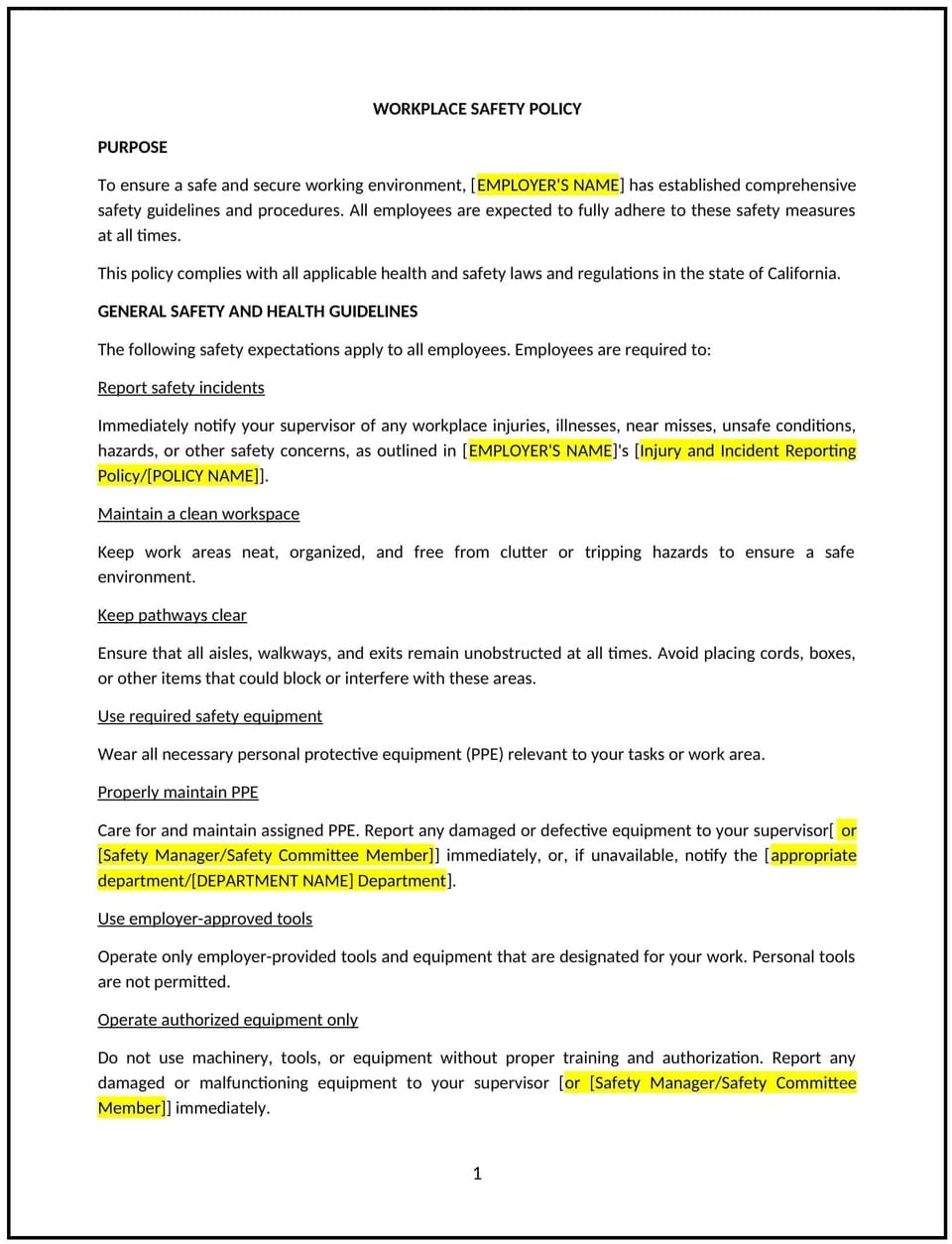Workplace safety policy (California): Free template

Workplace safety policy (California)
In California, a workplace safety policy provides businesses with guidelines for maintaining a safe and healthy work environment, as required by the California Occupational Safety and Health Act (Cal/OSHA). This policy outlines procedures for identifying, addressing, and preventing workplace hazards, and ensures compliance with Cal/OSHA standards.
By implementing this policy, California businesses can minimize the risk of workplace injuries, protect employee well-being, and maintain operational efficiency.
How to use this workplace safety policy (California)
- Define safety expectations: Clearly outline the safety standards employees are expected to follow, such as the use of personal protective equipment (PPE), safe handling of equipment, and adherence to workplace protocols.
- Conduct regular assessments: Establish procedures for identifying potential hazards in the workplace through regular safety audits and risk assessments.
- Communicate reporting procedures: Provide employees with clear instructions for reporting unsafe conditions, injuries, or near-misses.
- Outline emergency protocols: Ensure employees know how to respond to workplace accidents, fires, or other emergencies, including evacuation routes and first aid procedures.
- Promote ongoing training: Offer regular training sessions on workplace safety, including specific requirements for different job roles and safety equipment use.
Benefits of using this workplace safety policy (California)
This policy offers several advantages for California businesses:
- Supports compliance: Reflects Cal/OSHA regulations, ensuring the business meets state workplace safety requirements.
- Protects employees: Helps prevent injuries, illnesses, and accidents, creating a safer work environment.
- Reduces risks: Minimizes the potential for workplace safety violations and the associated legal and financial consequences.
- Improves morale: Promotes a culture of care and responsibility, which can lead to higher employee satisfaction and retention.
- Enhances reputation: Demonstrates the business’s commitment to employee well-being and legal compliance.
Tips for using this workplace safety policy (California)
- Reflect California-specific laws: Ensure the policy aligns with Cal/OSHA standards for workplace safety and health regulations.
- Conduct regular safety audits: Periodically assess the workplace for potential hazards and take corrective actions when necessary.
- Use clear signage: Post safety instructions and emergency procedures in visible areas of the workplace to ensure easy access for all employees.
- Train employees: Provide ongoing safety training to keep employees informed about risks and preventive measures in the workplace.
- Update regularly: Revise the policy to reflect changes in California laws, safety practices, or workplace conditions.
Q: How does this policy benefit the business?
A: This policy supports compliance with Cal/OSHA regulations, reduces the risk of workplace injuries, and helps foster a safe and productive work environment.
Q: What safety procedures are employees expected to follow?
A: Employees are expected to follow safety protocols such as wearing appropriate personal protective equipment (PPE), reporting hazards, and adhering to safe work practices.
Q: How does this policy support compliance with California laws?
A: The policy aligns with Cal/OSHA’s safety regulations and guidelines, ensuring that the business meets state-mandated safety requirements.
Q: What steps should employees take to report unsafe conditions?
A: Employees should notify their supervisor or the designated safety officer immediately and follow the reporting procedures outlined in the policy.
Q: How can the business improve workplace safety over time?
A: The business can conduct regular safety audits, offer additional training, and encourage employees to participate in identifying and addressing potential hazards.
This article contains general legal information and does not contain legal advice. Cobrief is not a law firm or a substitute for an attorney or law firm. The law is complex and changes often. For legal advice, please ask a lawyer.


